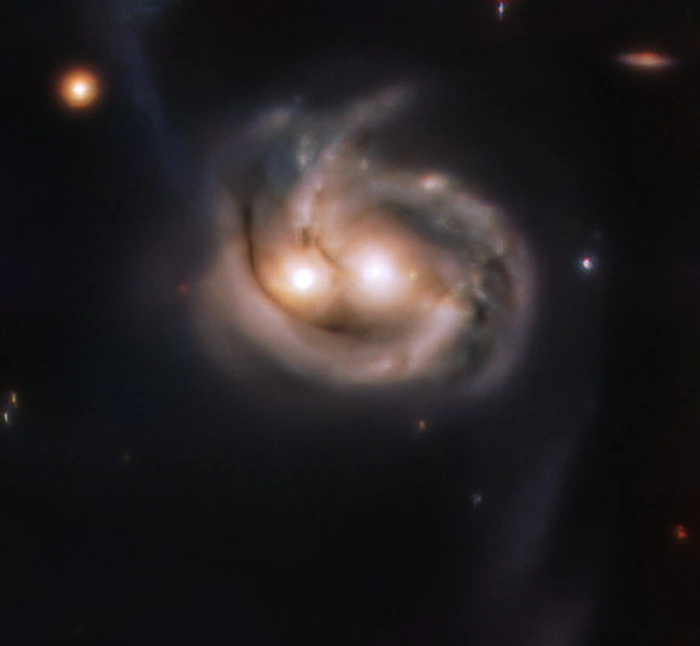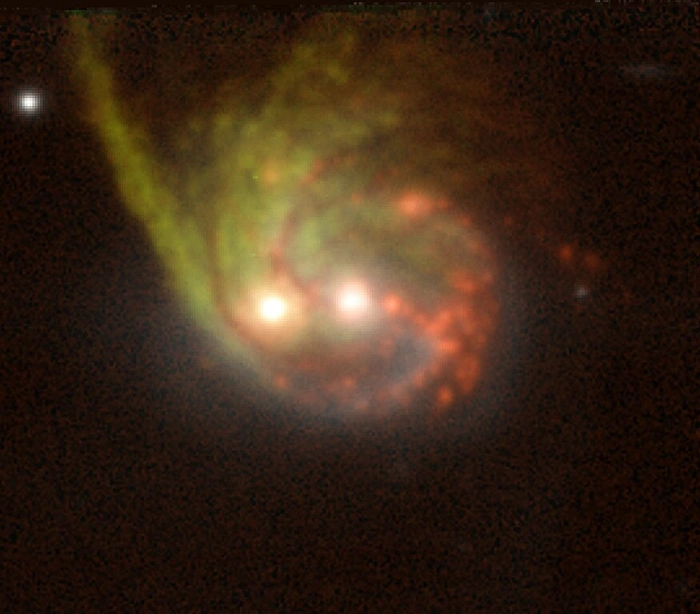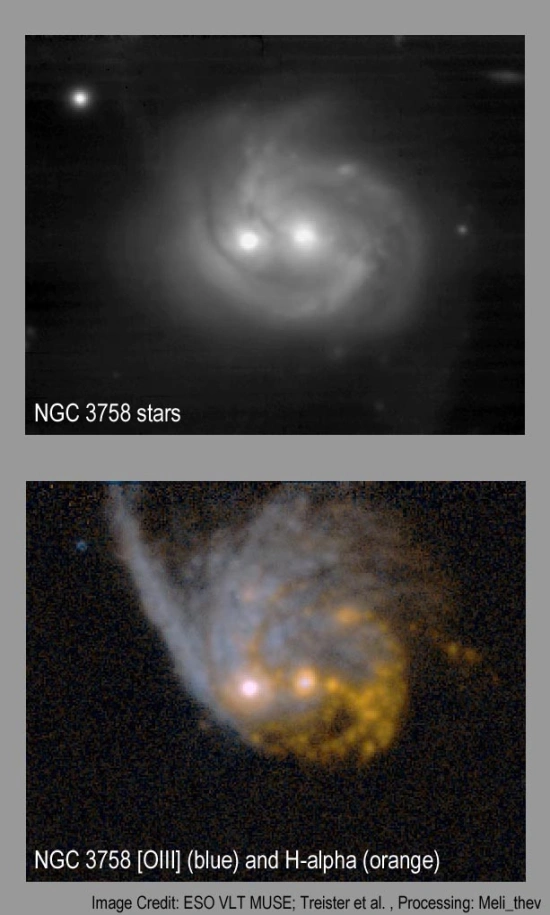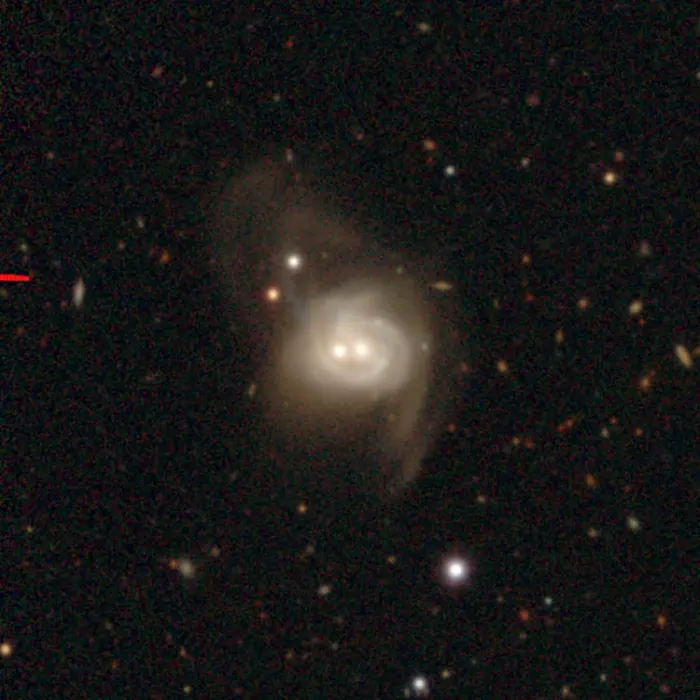The Owl Galaxy is a spiral galaxy located 447 million light-years away in the constellation Leo. With an apparent magnitude of 14.3 and an apparent size of 0.55 by 0.44 arcminutes, it is a challenging target for amateur telescopes. The galaxy is listed as NGC 3758 in the New General Catalogue. It is sometimes also called the Smiley Face Galaxy.
NGC 3758 earned its popular nicknames because it hosts a binary black hole. The two active galactic nuclei give the galaxy the appearance of a smiling face or a friendly owl’s head. Both black holes are active. They are only 11,000 light-years apart.
The Owl Galaxy is a rare example of a galaxy with a binary active galactic nucleus. It is the product of a merger between two smaller galaxies, each hosting a supermassive black hole. The two galaxies are catalogued as NGC 3758W and NGC 3758E. NGC 3758W is the foreground galaxy and NGC 3758E is the background companion. NGC 3758W is a young star-forming galaxy that is experiencing its first encounter with NGC 3758E.

This image shows the Owl Galaxy (Markarian 739), a pair of merging galaxies in the constellation of Leo. Image credit: ESO/Tubín et al. (CC BY 4.0)
The interacting system was classified as a dual AGN (active galactic nucleus) based on observations with the Chandra X-ray Observatory and the Swift observatory in 2011. The galaxy’s eastern nucleus was already known to contain an active black hole, the Chandra data confirmed that the western nucleus contained one, too. In visible, ultraviolet and radio wavelengths, the western nucleus showed no evidence of being an AGN, but its high X-ray energy was detected by Chandra and Swift.
NGC 3758 was identified as a dual AGN by a team led by Michael Koss of the at NASA’s Goddard Space Flight Center in Greenbelt, Md., and the University of Maryland in College Park (UMCP). Their findings were published in The Astrophysical Journal Letters.
NGC 3758 was only the second galaxy with a binary AGN identified within 500 million light-years of the Sun. The Starfish Galaxy (NGC 6240) in the constellation Ophiuchus lies even closer, 400 million light-years away. It is the remnant of a merger of three smaller galaxies and hosts three distinct nuclei.
NGC 3758W and NGC 3758E are gravitationally bound and their nuclei will fully merge in a few billion years. Astronomers have proposed that binary black holes that are about to merge can turn any nearby stars into hypervelocity stars – stars with velocities of around 1,000 km/s – and expel them out their host galaxies.

Owl Galaxy imaged with the MUSE instrument, image credit: ESO, VLT, MUSE; Treister et al., Meli Thev (CC BY-SA 4.0)
With a spatial diameter of 70,000 light-years, NGC 3758 is considerably smaller than the Milky Way. The Simbad database lists it as a lenticular galaxy (type S0).
The Owl Galaxy is classified as a Seyfert 1 type galaxy and a Markarian galaxy. Seyfert galaxies contain quasar-like nuclei with supermassive black holes surrounded by disks of infalling material. These disks emit strong ultraviolet radiation to give the galactic cores a luminosity comparable to that of the entire Milky Way. However, in visible light, these galaxies appear as normal spiral galaxies.
Type I Seyfert galaxies are characterized by both intense ultraviolet light and strong X-ray emission, as well as visible light emanating from their cores. Other examples of this class include the intermediate spiral galaxy, NGC 7469 in the constellation Pegasus, the spiral galaxy NGC 7314 in Piscis Austrinus, the unbarred lenticular galaxy NGC 5548 in Boötes, and the barred spiral galaxies NGC 4253 in Coma Berenices and NGC 1019 in Cetus.
The radiation of one or both active galactic nuclei in NGC 3758 ionizes an extended emission-line region (EELR), a giant interstellar cloud in the galaxy’s centre. The region was discovered in 2011 as part of the Galaxy Zoo project, which surveyed active galaxes for clouds ionized by the active galactic nuclei (AGNs). The region is much larger than the separation between the black holes. It stretches 17 kiloparsecs (55,447 light-years) from the nucleus.
The nuclei of Markarian galaxies show excessive amounts of ultraviolet emissions and have a blue colour that does not match the rest of the galaxy. The blue core is associated with hot, blue O- and B-type stars. The Owl Galaxy is catalogued as Markarian 739 (Mrk 739) in the Markarian catalogue.
In 2021, observations with the Multi Unit Spectroscopic Explorer (MUSE), an optical and near-infrared instrument on the Very Large Telescope (VLT) revealed that the AGN-ionized emission-line region extends up to 20 kiloparsecs from the nuclei and that regions of star formation were more centrally concentrated within 2 – 3 kiloparsecs. The astronomers proposed that the northern spiral arms of Mrk 739W are ionized by the nuclear activity of the galaxy’s companion, the elliptical galaxy Mrk 739E.
The team found that Mrk 739E is much older than Mrk 739W, and that the two galaxies have only begun to merge.

NGC 3758 with VLT’s MUSE instrument. The image shows oxygen [OIII] emission, as well as H-alpha emission. The oxygen emission maps the known giant AGN-ionized clouds, which were discovered by Keel et al. 2012. Credit: ESO, VLT, MUSE, Treister et al., Meli Thev (CC BY-SA 4.0)
Facts
NGC 3758 was discovered by the English astronomer Ralph Copeland on March 18, 1874. The French astronomer Édouard Stephan found the galaxy independently exactly ten years later, on March 18, 1884.
The galaxy has a namesake in the Owl Nebula (Messier 97), one of the brightest planetary nebulae in the sky. Like the Helix Galaxy (NGC 2685) and the Helix Nebula (NGC 7293) and the Cat’s Eye Galaxy (Messier 94) and the Cat’s Eye Nebula (NGC 6543), the two objects are not related. The Owl Nebula is the remnant of a star that reached the end of its life cycle and expelled its outer layers into space. The famous planetary nebula lies in the constellation Ursa Major, near Merak (β Ursae Majoris) in the region of the Big Dipper. Even though it is tiny compared to the Owl Galaxy, with an apparent size of 3.4 by 3.3 arc minutes, it is a much easier target for amateur astronomers. It can be seen in binoculars and small telescopes.

NGC 3758, credit: Legacy Surveys / D. Lang (Perimeter Institute), NERSC (CC BY-SA 4.0)
Location
The Owl Galaxy lies in the constellation of Leo. It appears in the region above the celestial Lion’s hindquarters. The constellation figure of the celestial Lion is easy to spot because it looks like the animal it represents.
The best time of the year to observe NGC 3758 and other deep sky objects in Leo is during the month of April, when the constellation appears higher above the horizon in the early evening.
At declination +21° 35’, the Owl Galaxy is theoretically visible from virtually any inhabited location on Earth for at least part of the year. It is best observed in larger telescopes at high magnification.

The location of the Owl Galaxy (NGC 3758), image: Stellarium
Owl Galaxy – NGC 3758
| Constellation | Leo |
| Object type | Spiral galaxy |
| Morphological type | Sb or Sab pec (S0) |
| Right ascension | 11h 36m 29.3703820296s |
| Declination | +21° 35’ 45.984535728’’ |
| Apparent magnitude | 14.3 |
| Apparent size | 0.550 x 0.440’ |
| Distance | 447 million light-years (137 megaparsecs) |
| Redshift | 0.029771 |
| Heliocentric radial velocity | 8,909 km/s |
| Size | 70,000 light-years |
| Names and designations | Owl Galaxy, Smiley Face Galaxy, NGC 3758, LEDA 35905, PGC 35905, PGC 165579, AGC 210506, Markarian 739 (Mrk 739), CGCG 126-110, RBS 1003, KUG 1133+218, MCG +04-27-073, 2E 2490, 2E 1133.8+2152, IRAS 11338+2152, IRAS F11338+2152, 2MASX J11362932+2135454, PBC J1136.4+2134, PSCz Q11338+2152, SWIFT J1136.4+2132, SWIFT J1136.5+2132, UZC J113629.1+213546, CAIRNS J113629.34+213546.2, CAIRNS J113628.96+213546.4, REIZ 1338, SFRS 149, AKRAI J1136286+213546, [MWI88] ACO 1367 6, Z 126-110, Z 1133.8+2152, NVSS J113629+213549, 1RXS J113629.4+213552 |